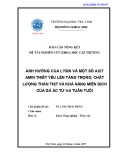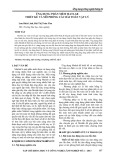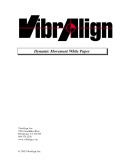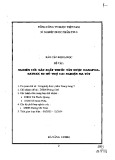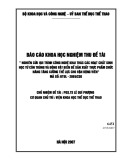
Schemes of flux control in a model of
Saccharomyces cerevisiae
glycolysis
Leighton Pritchard and Douglas B. Kell
Institute of Biological Sciences, University of Wales, Aberystwyth, UK
We used parameter scanning to emulate changes to the
limiting rate for steps in a fitted model of glucose-derepressed
yeast glycolysis. Three flux-control regimes were observed,
two of which were under the dominant control of hexose
transport, in accordance with various experimental studies
and other model predictions. A third control regime in which
phosphofructokinase exerted dominant glycolytic flux con-
trol was also found, but it appeared to be physiologically
unreachable by this model, and all realistically obtainable
flux control regimes featured hexose transport as a step
involving high flux control.
Keywords: yeast; metabolic control analysis; glycolysis;
modelling; flux.
In vivo and in vitro investigations of metabolic pathways can
be complex and expensive. The need to focus efficiently both
monetary and physical effort necessitates that some path-
ways and organisms will be only partially explored by
experiment, while others will be neglected completely.
Bioinformatic and computational approaches offer a means
of obtaining full value from experimentally acquired data,
extending their interpretation, suggesting novel hypotheses
for future experiments and guiding the experimentalist
towards potentially rewarding investigations but away from
likely fruitless ones. In this paper, we use such an approach,
parameter scanning, to investigate the operation of a model
of glucose derepressed yeast glycolysis (fitted by evolution-
ary computing to experimental data) under a far wider
range of conditions than could be considered in vitro or
in vivo, which suggests opportunities for further experiment.
Glycolysis is perhaps the most important pathway in the
metabolism of many living cells, describing the conversion
of glucose (and sometimes other hexoses) to pyruvate and
thence, in some organisms, to ethanol. In this conversion
two molecules of ATP are consumed and four molecules of
ATP are generated, providing a major source of negotiable
energyfor the cell. The glycolytic pathway, though crucial
to each, varies in detail between organisms [1]; for largely
economic reasons, greater effort has gone into the under-
standing of glycolysis in some organisms than in others.
Brewer’s yeast Saccharomyces cerevisiae, and in particular
its glycolytic pathway, is of great economic importance, not
least for the production of ethanol in the brewing and
distilling industries. The study of yeast glycolysis has thus
been the focus of scientific interest for over a century. In
pregenomic studies, the enzymes and metabolites that make
up the pathway were considered to have been elucidated
completely [2], but the solution of the S. cerevisiae genome
added further to this knowledge, and it is widely considered
that this organism currently possesses the best-investigated
and best-understood glycolytic pathway.
Much effort has already been invested in mathematical
modelling of the glycolytic pathway in yeast [3–8] and in
other organisms, such as Trypanosoma brucei, the parasite
that causes sleeping sickness [9–12]. The success and utility
of modelling in the study of T. brucei glycolysis has even led
to the coining of a new strategy for the investigation of
metabolism: computer experimentation [11]. This is inten-
ded to be a substitute for practical experimentation, and
must be based on precise kinetic knowledge of the system.
For yeast glycolysis, the most complete model to date was
constructed in order to test whether combining the
properties of the individual enzymes in isolation would
yield a proper description of the pathway as a whole [7].
This work provided a unique and highly valuable set of
in vitro kinetic and physical data obtained under a consistent
set of conditions (rare in the field [13]), and represented a
major step towards such computer experimentation in yeast.
In this paper, and in the spirit of computer experimen-
tation, we use the parameter scanning functions of
GEPASI
[14–16] to generate over 8000 models of glucose-derepressed
yeast glycolysis in order to test the flux-control character-
istics of the Teusink et al. model [7] under a wide range of
enzyme limiting rates. The limiting rates for 13 steps of the
model were scanned independently in all combinations by
an overall factor of four. In this way we explore the flux-
control behaviour of the model within the limits of its
Correspondence to D. B. Kell, Cledwyn Building,
Institute of Biological Sciences, University of Wales,
Aberystwyth, Wales, UK, SY23 3DD.
Fax: + 44 1970622354, Tel.: + 44 1970622334,
E-mail: dbk@aber.ac.uk
Abbreviations: PCA, principal components analysis; CJ
X, flux control
coefficient for step X and flux J; FCC, flux control coefficient; Glyc,
glycogen branch; Succ, succinate branch; Treh, trehalose branch.
Enzymes: alcohol dehydrogenase (EC 1.1.1.1); adenylate kinase
(EC 2.7.4.2); aldolase (EC 4.1.2.13); enolase (EC 4.2.1.11);
glycerol-3-phosphate dehydrogenase (EC 1.1.99.5); glyceraldehyde-
3-phosphate dehydrogenase (EC 1.2.1.12); hexokinase (EC 2.7.1.1);
pyruvate decarboxylase (EC 4.1.1.1); phosphofructokinase
(EC 2.7.1.11); phosphoglucoisomerase (EC 5.3.1.9); phosphoglycerate
kinase (EC 2.7.2.3); phosphoglycerate mutase (EC 5.4.2.1); pyruvate
kinase (EC 2.7.1.40); triosephosphate isomerase (EC 5.3.1.1).
Note: a web site is available at http://qbab.dbs.aber.ac.uk
(Received 24 January 2002, revised 10 June 2002,
accepted 18 June 2002)
Eur. J. Biochem. 269, 3894–3904 (2002) FEBS 2002 doi:10.1046/j.1432-1033.2002.03055.x





